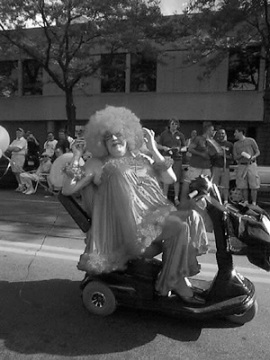Buffalo Gay, Lesbian, Bisexual, Transgender Archives
The History of the Gay, Lesbian, Bisexual and Trangendered Community in Buffalo, NYLGBT film archive started
The UCLA Film & Television Archive and Outfest, a leading showcase for diverse, international lesbian, gay, bisexual and transgender (LGBT) film and video, partnered in 2005 to create the Outfest Legacy Project for LGBT Film Preservation. The only program of its kind in the world, the Legacy Project has already established the world’s largest publicly accessible collection of LGBT films. UCLA and Outfest now announce the first two feature films slated to be restored as part of this landmark collaboration: “Parting Glances” (1986) starring Steve Buscemi and the groundbreaking “Word is Out: Stories of Some of Our Lives” (1978).
its kind in the world, the Legacy Project has already established the world’s largest publicly accessible collection of LGBT films. UCLA and Outfest now announce the first two feature films slated to be restored as part of this landmark collaboration: “Parting Glances” (1986) starring Steve Buscemi and the groundbreaking “Word is Out: Stories of Some of Our Lives” (1978).
While mainstream films are both collected by nonprofit archives and cared for by the commercial film industry itself, independent films are largely overlooked. LGBT independent films—including significant titles from the 1970s, 1980s and 1990s—are in particular peril because of a perceived lack of commercial value by the industry and/or the filmmakers’ inability to maintain their work themselves.
Because the components of many notable LGBT titles are degraded, altered or missing, the Legacy Project is working to raise funds to restore these films to their initial release forms. The preservation of “Parting Glances” and “Word is Out: Stories of Some of Our Lives” is an important first step in ensuring the survival of important and endangered LGBT works.
The Mattachine Forms
The Mattachine Society was named by Harry Hay, inspired by a French medieval and renaissance masque group he had studied while preparing a course on the history of popular music for a workers’ education project. In a 1976 interview with Jonathan Ned Katz, Hay was asked the origin of the name Mattachine. He mentioned the medieval-Renaissance French Sociétés Joyeux:
- “One masque group was known as the ‘Société Mattachine.’ These societies, lifelong secret fraternities of unmarried townsmen who never performed in public unmasked, were dedicated to going out into the countryside and conducting dances and rituals during the Feast of Fools, at the Vernal Equinox. Someti
 mes these dance rituals, or masques, were peasant protests against oppression — with the maskers, in the people’s name, receiving the brunt of a given lord’s vicious retaliation. So we took the name Mattachine because we felt that we 1950s Gays were also a masked people, unknown and anonymous, who might become engaged in morale building and helping ourselves and others, through struggle, to move toward total redress and change.”
mes these dance rituals, or masques, were peasant protests against oppression — with the maskers, in the people’s name, receiving the brunt of a given lord’s vicious retaliation. So we took the name Mattachine because we felt that we 1950s Gays were also a masked people, unknown and anonymous, who might become engaged in morale building and helping ourselves and others, through struggle, to move toward total redress and change.”
This French group was named in turn after Mattacino (or the Anglicized Mattachino), a character in Italian theater. Mattacino was a kind of court jester, who would speak the truth to the king when nobody else would. The “mattachin” (from Arabic mutawajjihin — “mask-wearers”) were originally Moorish (Hispano-Arab) sword-dancers who wore elaborate, colorful costumes and masks.
The Mattachine Society used so-called harlequin diamonds as their emblem. The design consisted of four diamonds arranged in a pattern to form a larger diamond.
Dealing with GRIDS
At that time, it was called GRIDS: Gay Related Immune Deficiency Syndrome. No one knew where it came from, but everyone was becoming scared.
Hello world!
Welcome to the new blog format home of the Buffalo GBLT archives. Switching to this format will allow us to be more active in our updates and will also make it easier for us to post and collaborate. Now, all of our members will be able to post items, and we will be able to do our work from many locations, not just one.
We hope to text and scan many of our printed materials, and we invite your stories and remembrances of Buffalo’s past.
Many of the people who have worked with us in the past have “lived” the history of the community, but we also have young and eager interns who are taking pride in their history while learning archival and cataloging techniques.
We are always seeking donations of collections, volunteers, and monetary donations. Please use any of the comment sections to get in touch with us (your email is given to us but is not public).
Please use the index tab to view archive items we have posted. Our regular posts in these sections will keep you informed on our progress, articles of interest, and the fascinating history of the Buffalo’s GBLT community.


